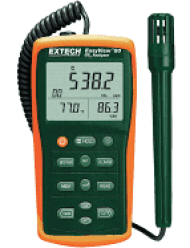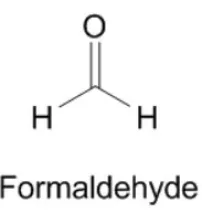Testing for Formaldehyde and VOCs
Wellness Inspection: Sometimes occupants become desensitized to the odors around them, but that does not mean that these chemicals, such as formaldehyde and others, stop affecting them and complain of symptoms such as throat irritation, nose, eyes, and skin continue even with the absence of an odor. Years of experience have taught us that it is not only testing but taking inventory of the surroundings and removing the cause of the irritant. That is why our holistic air can be sampled, and quantitative analysis of the concentration of Formaldehyde and TVOC can be provided. This could be required after a fire and smoke event, where large amounts of complex particulates are created, often VOCs.
Formaldehyde is a colorless, strong-smelling gas. It is produced naturally by humans, plants (mainly wood), and animals. Many men-made materials also contain formaldehyde, including engineered wood products (e.g., particle board, plywood, OSB, MDF, flooring, etc.), some preservatives, personal care and cleaning products, cosmetics, permanent press fabrics, glues, air fresheners, paints, and coatings. Formaldehyde is also a byproduct of combustion, including vehicle exhaust, fuel-burning appliances (gas stoves, kerosene space heaters, etc.), fireplaces, wildfires, structural fires, tobacco smoke, and trash fires. Formaldehyde is a known human carcinogen (cancer-causing agent); it can also cause nasal and eye irritation, increased risk of asthma and allergies, and neurological effects. At concentrations over 500 ppb, it can also cause eczema and changes in lung function. Animal studies also showed decreased body weight, gastrointestinal ulcers, and liver and kidney damage at high doses.



Formaldehyde Sources
There are many possible sources for formaldehyde in a home, although building products typically comprise a large proportion of the concentration. Any recent renovation or new materials brought into the home will likely increase the formaldehyde levels. The concentration will decrease over time as the materials are off-gas. Hence, increasing the ventilation as much as possible is typically the best way to quickly decrease the formaldehyde in your home after the recent renovation or installation of new materials.
- Laminate floors
- Cabinetry
- Pressed wood products {particle board, plywood paneling, and medium-density fiberboard (MDF)
- Foam insulation
- Carpets
- Drapery fabrics
- Resins; glues
- Cigarettes
- Un-vented fuel-burning appliances {gas stoves or kerosene heaters}
- Products that contain urea-formaldehyde (UF) resins
- Products that contain phenol-formaldehyde (PF) resins (lower concentrations of formaldehyde than UF resins)
- Softwood plywood, flake, or oriented strand board
- Pre-finished engineered flooring
- Insulation
- Glues and adhesives
- Paints and coatings
- Textiles
- Disinfectant cleaning products and soaps
- Preservatives
- Personal care products, especially certain hair products
- Cosmetics
- Pet care products
- Combustion byproduct (burning)
- Tobacco smoke and fuel-burning appliances (gas stoves, kerosene space heaters, and fireplaces)
- TVOC is an organic compound (those containing carbon) that is readily volatile or evaporated at “room” temperature. Some organizations define this by the boiling point range of the compounds, approximately 50 to 250 degrees C.
- VOCs can cause various symptoms, especially for more sensitive groups like children, pregnant women, elderly. They can also exacerbate existing conditions such as asthma. VOCs can also affect the ability to concentrate and have other less noticeable effects. Possible Symptoms: Respiratory discomfort including wheezing, burning sensation in the throat, scratchy throat, shortness of breath, Skin reactions including rash, burning sensation, Eye irritation, Organ and tissue damage (minor to cancer)
Exposure Guidelines for Homes
Although no requirements are set for formaldehyde concentration limits in homes, several recommendations may be helpful. Many organizations or government authorities suggest formaldehyde concentrations not exceed 100-120 ng/L (80-100 parts per billion or ppb) and 50-60 ng/L (40-50 ppb) for short-term and longer-term exposures, respectively. Some organizations or government authorities recommend more stringent levels for longer-term exposures. In general, formaldehyde concentrations should be kept as low as reasonably achievable. Most homes measured by Prism’s air test have concentrations in the range of 30 to 70 ng/L
For an occupational exposure reference, the National Institute for Occupational Safety and Health (NIOSH) has set a recommended exposure limit (REL) of 20 ng/L (16 ppb). The Occupational Safety and Health Administration (OSHA) has set a workplace permissible exposure limit (PEL) of 940 ng/L (750 parts per billion).
Significant Health Effects of Formaldehyde Exposure
Health effects vary depending on the individual. Common symptoms of acute exposure include irritation of the throat, nose, eyes, and skin; this irritation can potentially exacerbate asthma symptoms and other respiratory illnesses. Long-term or chronic exposure may also cause a runny nose, chronic bronchitis, and obstructive lung disease. In 2004, the International Agency for Research on Cancer (IARC) reclassified formaldehyde from “probably carcinogenic to humans” to “carcinogenic to humans” related to nasopharyngeal cancer. Since many factors are involved in cancer development, no definitive “safe level” of exposure has been established. The best way to reduce the risk of cancer is to limit exposure.
Naturally Occurring Formaldehyde Sources
Formaldehyde is also produced naturally in living systems, e.g., trees and other plant life, and during decay and combustion processes. Formaldehyde is also involved in atmospheric processes. Outdoor concentrations of formaldehyde from natural and man-made sources can range from less than 1 ng/L in remote areas to 10-20 ng/L in urban environments.

 786-800-4598
786-800-4598 info@uhsmold.com
info@uhsmold.com